Rose Chafer Beetle
- April 9, 2024
- 0 comment
The Rose Chafer Beetle, scientifically known as Cetonia aurata, is a captivating insect renowned for its striking appearance and ecological significance. Sporting an iridescent green-gold hue, these beetles are a common sight in gardens, meadows, and agricultural fields across various continents. Their physical characteristics, including fan-shaped antennae and graceful flight patterns, make them easily distinguishable. Despite their charming appearance, Rose Chafer Beetles can be a nuisance to gardeners and farmers due to their voracious appetite for flowers and foliage.
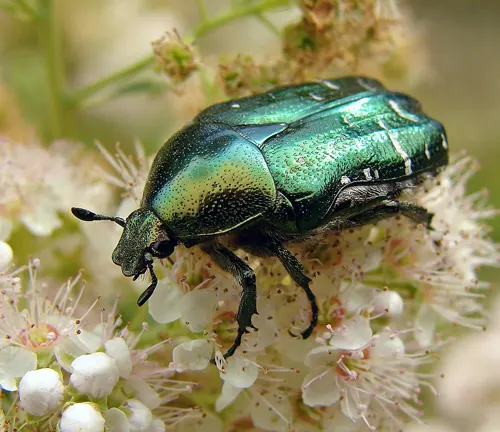
While they play a crucial role as pollinators, aiding in the reproduction of numerous plant species, their feeding habits can lead to defoliation and crop damage when populations surge. Understanding the life cycle and behavior of Rose Chafer Beetles is essential for implementing effective management strategies that balance conservation efforts with pest control measures. Through integrated pest management practices and sustainable gardening techniques, we can mitigate the impact of these beetles while preserving their ecological contributions.
| Specification | Description |
|---|---|
| Scientific Name | Cetonia aurata |
| Common Name | Rose Chafer Beetle |
| Family | Scarabaeidae |
| Size | Approximately 1.5 centimeters in length |
| Color | Iridescent green-gold |
| Antennae | Long and fan-shaped |
| Habitat | Gardens, meadows, agricultural fields |
| Distribution | Europe, Asia, North America, temperate regions |
| Lifecycle Stages | Egg, larva, pupa, adult |
| Feeding Habits | Pollen, nectar, flowers, foliage |
| Activity | Diurnal, active during warm and sunny weather |
| Predators | Birds, reptiles, parasitic insects |
| Economic Impact | Crop damage, defoliation, economic losses for growers |
| Conservation Status | Not evaluated |
| Cultural Significance | Symbolic association with renewal, abundance, themes in folklore and mythology |
| Ecological Role | Pollinator, decomposer, prey for other organisms |
| Management Techniques | Integrated pest management, sustainable gardening practices |
| Challenges | Pesticide exposure, habitat loss, invasive species, climate change |
| Importance in Research | Studies on ecology, behavior, interactions with environment |
Rose Chafer Beetle: Understanding the Pests in Your Garden
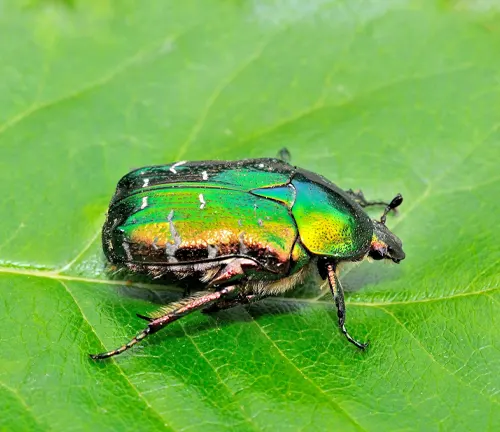
The Rose Chafer Beetle, scientifically known as Cetonia aurata, is a common insect found in gardens, meadows, and agricultural fields across many parts of the world. Belonging to the family Scarabaeidae, this beetle is recognized for its iridescent green-gold coloration and graceful flight patterns.
Physical Characteristics of Rose Chafer Beetle
The Rose Chafer Beetle, possesses distinct physical characteristics that make it easily recognizable in its habitat. One notable feature is its compact body, which typically measures around 1.5 centimeters in length. The most striking aspect of the Rose Chafer Beetle is its iridescent coloration, which ranges from shimmering green to gold, giving it a captivating appearance.
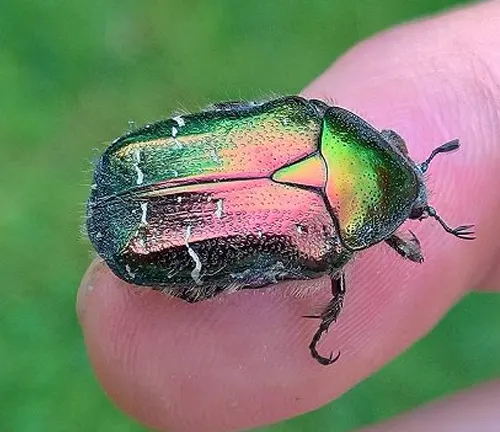

Coloration and Adaptations
The shimmering green-gold color of the Rose Chafer Beetle serves both as camouflage and as a means of attracting mates during the breeding season. This coloration also acts as a warning signal to potential predators, indicating that they are distasteful or toxic.
Habitat and Distribution
The Rose Chafer Beetle, is found in a variety of habitats across different continents. These beetles thrive in temperate regions of Europe, Asia, and North America, where they inhabit diverse ecosystems ranging from woodlands and grasslands to gardens and agricultural fields.

One characteristic habitat favored by Rose Chafer Beetles is areas with sandy soil, as it provides suitable conditions for their larvae to develop underground. However, they are also adaptable and can be found in a wide range of soil types as long as there is access to suitable food sources and breeding sites.

Range Expansion
The range of the Rose Chafer Beetle has experienced expansion in recent years, influenced by various factors such as climate change and human activities. Historically found primarily in temperate regions of Europe, Asia, and North America, these beetles have gradually expanded their distribution to new areas.
Climate change, in particular, has played a significant role in facilitating the range expansion of Rose Chafer Beetles. Warmer temperatures and altered precipitation patterns have created more favorable conditions for beetle survival and reproduction in regions where they were previously less common. Additionally, human activities such as transportation and trade have inadvertently facilitated the spread of Rose Chafer Beetles to new locations, often unintentionally introducing them to non-native habitats.
Life Cycle of Rose Chafer Beetle
The life cycle of the Rose Chafer Beetle, scientifically known as Cetonia aurata, encompasses several distinct stages that contribute to its growth and reproduction.
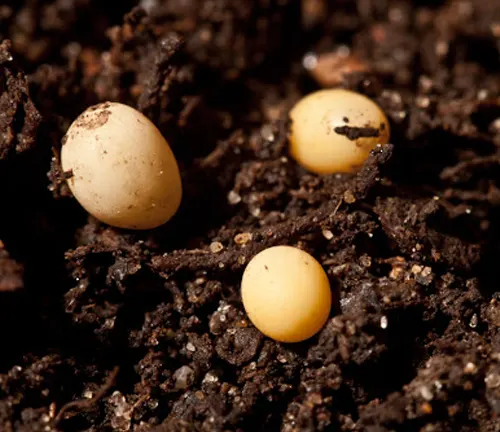
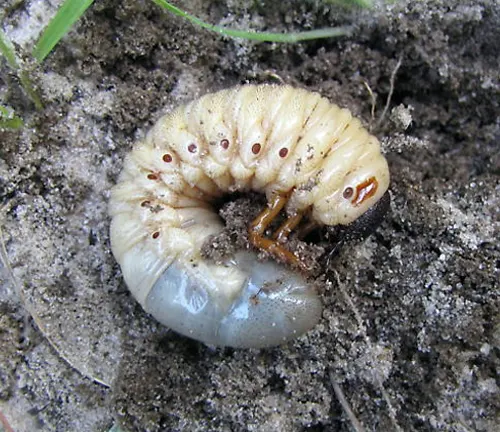
- Egg Stage: The life cycle begins when female Rose Chafer Beetles lay their eggs in the soil during the summer months. These eggs are typically deposited in clusters near suitable food sources, such as decaying organic matter or plant roots.
- Larval Stage: Upon hatching, the eggs give rise to creamy white larvae, commonly referred to as grubs. These larvae possess voracious appetites and feed on organic matter in the soil, including plant roots and decaying vegetation. The larval stage is crucial for the growth and development of the beetle, lasting several months to a year, depending on environmental conditions.
- Pupal Stage: After completing their growth and development, the larvae enter the pupal stage, where they undergo metamorphosis into adult beetles. Pupation typically occurs underground, where the pupae are protected from predators and environmental fluctuations. During this stage, significant physiological changes occur as the larvae transform into fully-formed adult beetles.
- Adult Stage: The final stage of the Rose Chafer Beetle’s life cycle is the emergence of adult beetles from their pupal cases. Adult beetles emerge from the soil in late spring or early summer, coinciding with the flowering season of many plants. Upon emergence, adult beetles feed on pollen, nectar, and flowers, and engage in mating behavior to reproduce and continue the life cycle.
Pupal Stage and Metamorphosis
The pupal stage is a critical phase in the life cycle of the Rose Chafer Beetle, marking the transition from larva to adult beetle. After completing their period of feeding and growth as larvae, Rose Chafer Beetles enter the pupal stage, where they undergo metamorphosis.
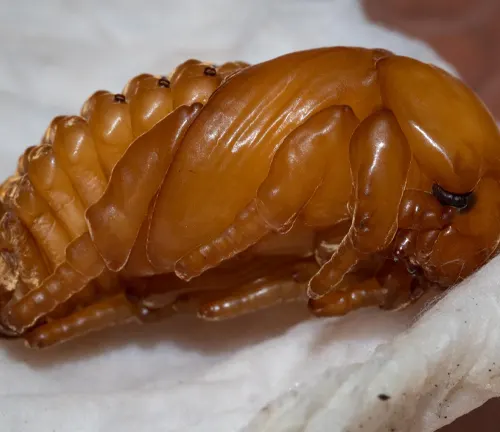
Pupation typically occurs underground, where the larvae construct protective chambers in the soil. Within these chambers, physiological changes take place as the larvae transform into adult beetles. The pupal stage is characterized by the reorganization of tissues and the development of adult structures, including wings, antennae, and reproductive organs.
Metamorphosis is a complex process that unfolds over several weeks, culminating in the emergence of fully-formed adult beetles from their pupal cases. Once emerged, adult beetles surface from the soil and begin their journey in search of food and mates, marking the beginning of a new generation.
Behavior and Feeding Habits
Rose Chafer Beetles exhibit specific behaviors and feeding habits that play a significant role in their ecology and interactions with their environment. These beetles are primarily active during the day, especially in warm and sunny weather conditions. They can be frequently observed foraging for food on flowers and foliage of various plant species.
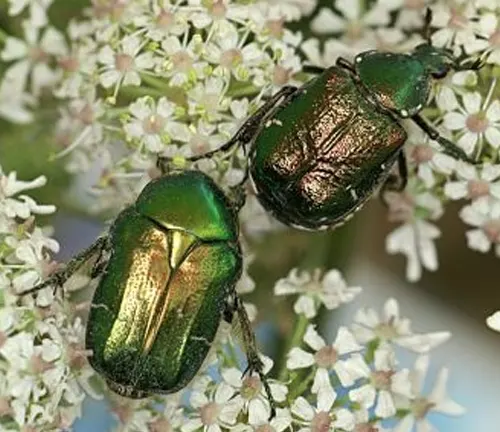
The feeding habits of Rose Chafer Beetles are diverse, as they consume a wide range of plant materials. They feed on pollen, nectar, flowers, and foliage, with a particular preference for fragrant flowers and those with abundant pollen. Their voracious appetite can lead them to move from one plant to another in search of food, often congregating in large numbers on favored floral resources.
Pollination
Rose Chafer Beetles are important pollinators in their ecosystems, contributing to the reproductive success of numerous plant species. As they feed on flowers and move from one plant to another, they transfer pollen between flowers, facilitating fertilization and seed production. This process is essential for the reproduction of flowering plants, including many agricultural crops and wildflowers.
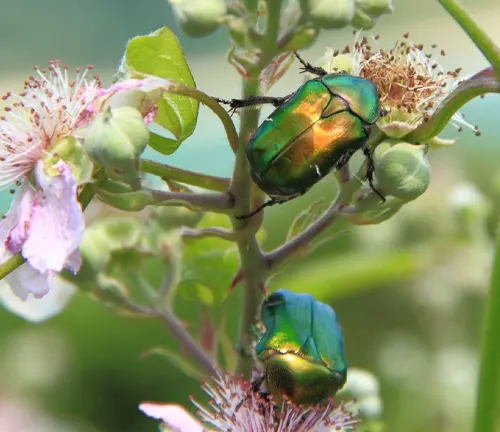
Impact on Plants and Crops
Although Rose Chafer Beetles play a role in pollination, their voracious appetite for flowers and foliage can pose significant challenges to gardeners and farmers. Infestations of these beetles can result in defoliation, reduced crop yields, and aesthetic damage to ornamental plants.

Agricultural Damage
In agricultural settings, Rose Chafer Beetles are known to feed on a variety of crops, including grapes, strawberries, and various tree fruits. Severe infestations can lead to economic losses for growers and impact the quality and quantity of harvests.
Natural Predators and Control Measures
Rose Chafer Beetles have several natural predators that help regulate their populations, including birds, reptiles, and other insects. Additionally, certain microbial pathogens and parasitic wasps can infect and kill beetle larvae, reducing their numbers in the environment.
Integrated Pest Management (IPM)
For gardeners and farmers dealing with Rose Chafer Beetle infestations, integrated pest management (IPM) practices offer sustainable and environmentally friendly solutions. These may include cultural methods, biological controls, and targeted use of insecticides when necessary.
Prevention and Management Techniques
Preventing Rose Chafer Beetle damage begins with implementing proactive measures to deter or control their populations. Strategies such as crop rotation, mulching, and the use of physical barriers can help reduce beetle numbers and protect vulnerable plants.
Companion Planting
Companion planting with species that repel or distract Rose Chafer Beetles can be an effective strategy for managing infestations. Plants such as garlic, marigolds, and rue are known to have natural repellent properties against these pests.
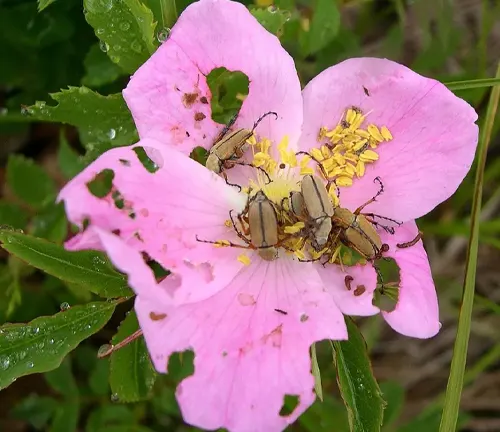
Economic Importance
Despite their pest status, Rose Chafer Beetles also have economic importance in certain industries. For example, they are utilized in some regions as indicators of habitat quality and biodiversity due to their sensitivity to environmental changes.
Research and Monitoring
Ongoing research into the ecology and behavior of Rose Chafer Beetles is essential for developing effective management strategies and mitigating their impacts on agriculture and horticulture.
Rose Chafer Beetle in Gardening
In gardening, understanding the life cycle and behavior of Rose Chafer Beetles can help gardeners make informed decisions about plant selection, pest management, and conservation practices.
Sustainable Gardening Practices
By adopting sustainable gardening practices such as composting, organic mulching, and promoting biodiversity, gardeners can create resilient ecosystems that are less susceptible to pest outbreaks.
Cultural Significance
In some cultures, the Rose Chafer Beetle holds symbolic significance and is associated with themes of renewal, transformation, and abundance. Its appearance in folklore and mythology reflects its role as a harbinger of seasonal changes and natural cycles.
Folklore and Symbolism
Throughout history, the Rose Chafer Beetle has been depicted in art, literature, and folklore as a symbol of beauty, vitality, and the ephemeral nature of life. Its presence in gardens and meadows evokes a sense of wonder and connection to the natural world.
Ecological Role
Beyond their interactions with humans, Rose Chafer Beetles play important ecological roles as pollinators, decomposers, and prey for other organisms. Their presence contributes to the health and functioning of diverse ecosystems.
Ecosystem Services
By pollinating flowers and recycling organic matter, Rose Chafer Beetles contribute to the maintenance of biodiversity and ecosystem resilience. Protecting their populations is crucial for preserving the balance of natural communities.
Different Species
Cetonia aurata
The most well-known species, characterized by its iridescent green-gold coloration and presence in gardens and meadows across Europe, Asia, and North America.
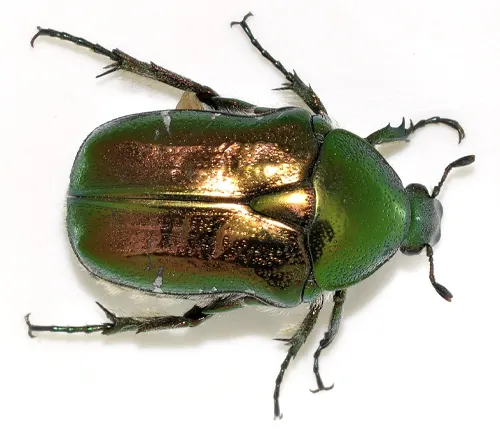

Cetonia marginalis
Also known as the “Margined Flower Chafer,” this species is found in North America and features a metallic green color with coppery-red margins on its elytra.
Cetonia pilifera
Native to parts of Africa, this species exhibits a similar metallic green coloration but may have different markings or patterns on its body compared to Cetonia aurata.
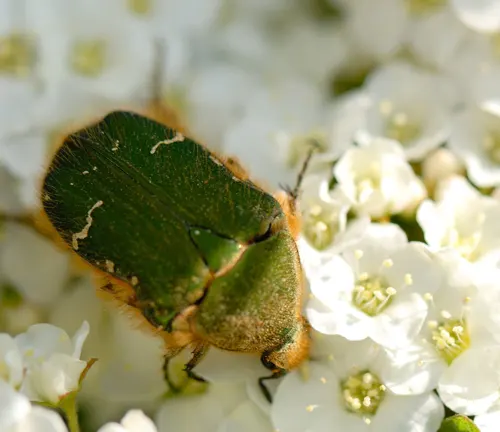
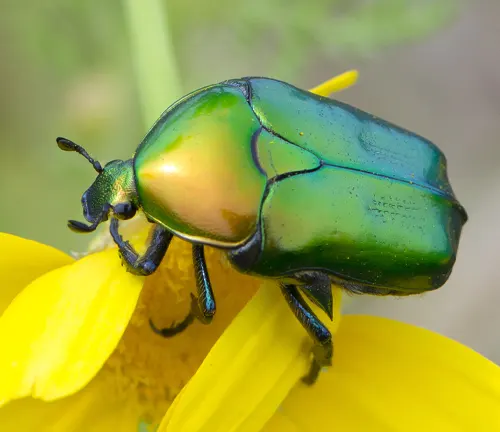
Protaetia cuprea
Commonly referred to as the “Copper Rose Chafer,” this species is found in Europe and parts of Asia, with a shiny copper-colored body and distinct ridges on its elytra.
Protaetia metallica
Also known as the “Metallic Chafer Beetle,” this species displays a metallic green or blue-green coloration and is found in Europe and parts of Asia.
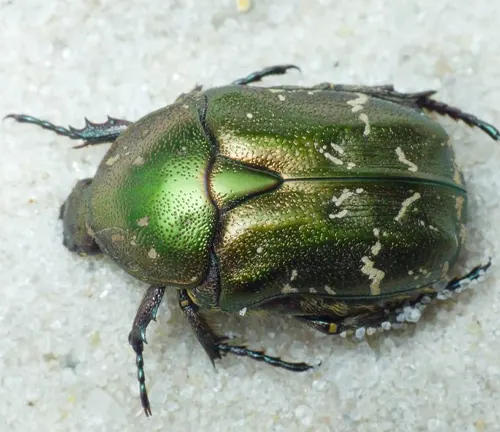

Trichiotinus piger
Found in North America, this species is commonly known as the “Eastern Flower Chafer” and has a bronze or coppery coloration with distinct longitudinal ridges on its elytra.
Frequently Asked Question (FAQs)
- What is a Rose Chafer Beetle?
A Rose Chafer Beetle is a type of scarab beetle known for its iridescent green-gold coloration and presence in gardens and agricultural fields. - Where are Rose Chafer Beetles found?
Rose Chafer Beetles are found in temperate regions of Europe, Asia, and North America, often in habitats with sandy soil. - What do Rose Chafer Beetles eat?
Rose Chafer Beetles feed on pollen, nectar, flowers, and foliage of various plants, including roses, lilies, and peonies. - Do Rose Chafer Beetles cause damage to plants?
Yes, in large numbers, Rose Chafer Beetles can cause damage to plants by defoliating leaves and consuming flowers, which can impact crop yields and aesthetics. - How can I identify Rose Chafer Beetles?
Rose Chafer Beetles are typically around 1.5 centimeters in length and have a metallic green-gold coloration, with long, fan-shaped antennae. - When are Rose Chafer Beetles most active?
Rose Chafer Beetles are primarily active during the day, especially in warm and sunny weather conditions. - Are Rose Chafer Beetles beneficial insects?
Despite their pest status, Rose Chafer Beetles serve as important pollinators and contribute to ecosystem health. - How do I control Rose Chafer Beetles in my garden?
Integrated pest management (IPM) techniques, such as crop rotation, mulching, and biological controls, can help manage Rose Chafer Beetle populations. - Do Rose Chafer Beetles have any natural predators?
Yes, birds, reptiles, and parasitic insects are among the natural predators of Rose Chafer Beetles. - Are Rose Chafer Beetles attracted to specific plants?
Yes, Rose Chafer Beetles are attracted to a wide range of flowering plants, particularly those with fragrant flowers and abundant pollen. - Can Rose Chafer Beetles be controlled using traps?
Yes, pheromone traps and light traps can be used to monitor and reduce Rose Chafer Beetle populations in certain situations. - Do Rose Chafer Beetles overwinter in the soil?
Yes, Rose Chafer Beetle larvae typically overwinter in the soil before emerging as adults in the spring or early summer.


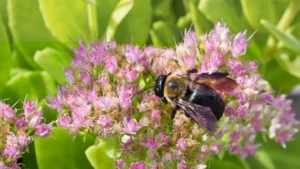
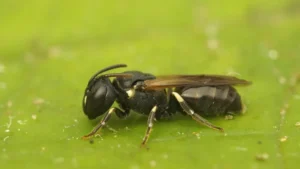

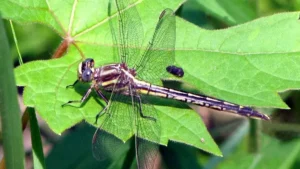
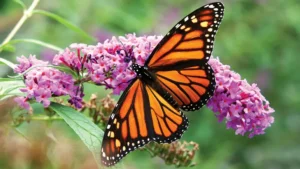
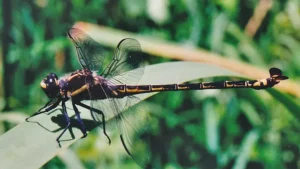
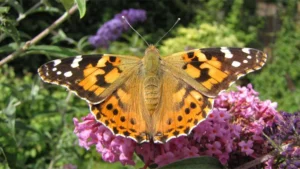
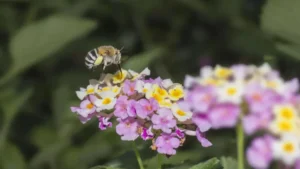
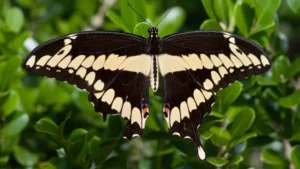


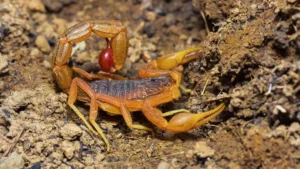
Leave your comment